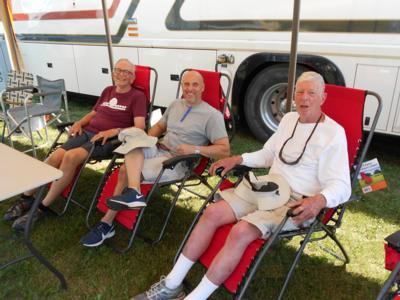The Cockpit Of The Skylab 1 Is Very Similar To That Of The Optica
"Around three years ago were sitting around one evening, doing what we do, which is talk about airplanes. We were beginning to think about our next project and what it could be/should be. One of our team hauled out a bunch of drawings and said, 'Here’s something I drew up one night when I couldn’t sleep—we definitely shouldn’t do this one.' So of course we’re doing it."

And such was the birth of what the three principals of Skylab Engineering -- Steve Martin, Stever Schultz and Dr. Jim -- intend to be a very unique hybrid aircraft, powered by a small generator supplying electric power to ten small electric engines along the leading edge of the wings. The goals of the program are simple. Electric and/or hybrid electric flight, good cross-country range and useful load, distributed electric thrust to yield a blown wing, outstanding visibility, simplicity of structure and a low part count and as the engineers put it, "Make everyone lose their minds."
For those of you who follow the funky output of the minds of aircraft engineers, you may remember the Edgley EA-7 Optica, a British light aircraft with huge bulbous canopy and a ducted fan for propulsion, designed for slow-speed observation work,as a low-cost alternative to helicopters. That aircraft is no longer in production, but a few examples still remain. You may also remember the twin-boom Ion which flew at Oshkosh several times. Now that same team is building this new design.
The cockpit of the Skylab 1 is very similar to that of the Optica, but there the similarity ends. Instead of a ducted fan with a conventional reciprocating engine, the Skylab 1 is powered by a small combustion engine generator which provides electricity to ten small electric motors mounted on the leading edge of the wings, and a set of batteries designed to provide a few minutes power in an emergency. The Optica had twin vertical stabilizers but the Skylab 1 is more conventional in this respect. The design of the aircraft is modular so as to allow for the fitting of new systems such as the engine should new technology become available that justifies it.
The airframe itself is made out of lightweight fiberglass, with a design empty weight of 1,100 lbs and a max gross weight of 1,900 lbs. Wingspan is 25 ft., length of the fuselage is 24 ft. The fuel tank sits underneath the genset and seats and holds 47 gals of fuel, which should yield a range of 500 nm or so at 150 kts cruise speed. The design of the airframe also brings simplicity of construction, because only two molds are needed, one for the airframe and another for the frontal "bowl" with room for two and a bit of luggage. The landing gear is fixed and made of spring aluminium.

You may have noticed mention of a "blown wing" a little earlier. A blown wing is type of wing where the airflow over the wing is powered rather than variable depending on the forward motion of the aircraft. This allows the designer to use a smaller wing and therefore greatly reduce drag. The use of electric motors mounted on the leading edge is what makes it possible to use this type of wing in this design.
Something else is unique about this aircraft -- it will not be manufactured for sale in any form. There will only be the one bird, and that's it. Once the program is completed and the aircraft has been flying for a while, the company and rights to the aircraft may be available for purchase. It's similar to the concept of startup companies in the technology world, but without the liability imposed by selling products. You may wonder if that's a smart thing to do, but this team has already done it once before.
 ANN's Daily Aero-Term (05.09.24): Hold Procedure
ANN's Daily Aero-Term (05.09.24): Hold Procedure ANN's Daily Aero-Term (05.06.24): Altitude Readout
ANN's Daily Aero-Term (05.06.24): Altitude Readout ANN's Daily Aero-Linx (05.06.24)
ANN's Daily Aero-Linx (05.06.24) Airborne-NextGen 05.07.24: AI-Piloted F-16, AgEagle, 1st 2 WorldView Sats
Airborne-NextGen 05.07.24: AI-Piloted F-16, AgEagle, 1st 2 WorldView Sats Aero-News: Quote of the Day (05.07.24)
Aero-News: Quote of the Day (05.07.24)




